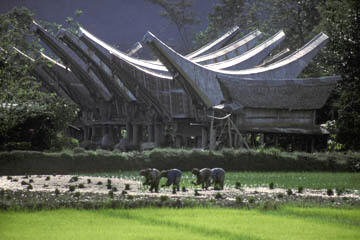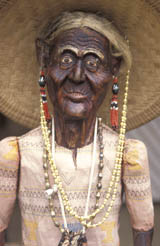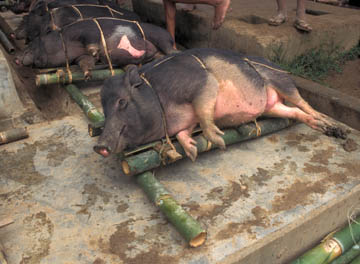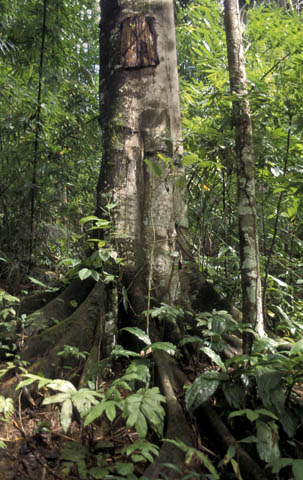
LAND OF THE LIVING DEAD
Deep in the Indonesian archipelago lies the island of Sulawesi. A fertile land of tropical jungle, mountains and lakes; it is without doubt one of the most fascinating islands on the planet. On the southeast part of the island in a valley, surrounded by mountains, is the highland province of Torajaland, acknowledged as on of the most beautiful regions of Indonesia.
The word “Toraja” means people of the mountains and this remote region has its own very distinct culture. When the rest of Indonesia was under Dutch control, Torajaland was still independent. It did not succumb to Dutch rule until 1906, although other parts of the island had been under Dutch control since the beginning of the 19th century. Seventy Five percent of the population of about 660,000 are Christian, but in the more remote areas the old religion of “Aluk Todolo” is still followed by most people. Ancestors are highly respected and the living and the dead, in the form of spirits, combined in all aspects of everyday life.

Toraja Longhouses
Community links are strong and whole families live together in wooden longhouses built on stilts, with curved roofs resembling Viking longboats. When someone dies the body is embalmed using herbs and spices, wrapped in sheets and placed in the longhouse where it “lives” with the rest of the family until after the funeral. An effigy of the dead person, known as a “Tau-Tau” is carved from the wood of the jackfruit tree, dressed in the person’s finest clothes and displayed outside the house. The soul of the deceased lives in the Tau-Tau until the funeral.

Tau-Tau,
An effigy of the dead person. Tau-Tau means small person
When the date is set, relatives, friends and those owing debts to the deceased start the trek to a specially created “burial village” armed with offerings. The objective of the funeral is to transport the soul of the deceased to heaven and allow the living to replay debts owed to that person. Offerings range from rice, chickens, wine and cigarettes leading to pigs and even buffalos for large debts. The funeral season runs from July to September but depending on the importance of the person and the debts owed the time from death to the funeral could be as much as 20 years.
We visited Sulawesi in August and after a tiring 10-hour overland journey arrived at Rantepeo, a bustling town and unofficial capital of the highlands. Our accommodation, a rest house, was modelled after a Toraja long house and built in the middle of a rice paddy. The people were all extremely friendly and we made contact with a local schoolteacher who proved to be a mine of information. Through his contacts we considered ourselves very privileged to be invited to attend the funeral of a Toraja nobleman. The gentleman in question had only been dead for 8 months!
A freak monsoon the previous evening, which locals say was caused by global warming, had converted the ground to a sea of mud. Undeterred, we trekked 6 miles through jungle, across a river on a bamboo bridge and finally up a mountain to the purposely built burial village.

Buffalo paraded before being slaughtered
The village consisted of a massive bullring surrounded by recently erected buildings that would house the guests during the ceremony, which was scheduled to last over three days. Three hundred and fifty guests paraded 28 buffalo, 200 pigs and an ocean of palm wine and smaller gifts in front of the family who carefully checked that debts had been correctly paid. Being privileged guests we brought with us gifts of cigarettes and sugar and were readily accepted by the family.

Pigs - Gifts for the family
My everlasting memory of this part of the proceedings will be the squealing of the pigs, which were quite distressed and somehow knew that for some the end was nigh. Finally all the guests walked in single file, in order of preference, past the body of the deceased. Some of the animals were then slaughtered, the blood saved in bamboo tubes for cooking and the festivities commenced, eating and drinking for three days.

Tau-Tau Gallery
The body was then transferred in a wooden coffin to a cliff-side grave and the Tau-Tau placed in a gallery to watch over the people and the crop fields. The reason for this is twofold: to ensure the spirit protects the living and their crops and also to act as a reminder to the living to give proper respect to their ancestors. Ritual re-clothing of the Tau-Tau takes place at pre-determined intervals. It is believed that a stone ladder once connected earth to heaven, so burial in a stone slot or cave is very important, symbolising the start of the journey to the afterlife.

Over the years the wooden coffins rot and in the caves bones can be seen scattered around.

Tree Grave
A particularly sad sight is the tree graves. When a child dies the body is wrapped in a shroud and placed in a carved hollow in a tree trunk, which is then sealed. In time the tree grows around the bones and the spirit of the child becomes as one with the tree.
When the Dutch conquered the highlands in the early part of the 20th century the Reformed Church tried to convert people to Christianity. They were particularly keen to stop ritual sacrifice, but their efforts resulted in violent resistance. A more pragmatic approach was adopted and buffalo sacrifice was considered acceptable if the meat was subsequently served to the living. The Toraja funeral ritual was therefore saved. Although a very ancient religion, Aluk practices are still followed by a lot of people. In 1960 Aluk Todolo was officially recognised as a branch of Hinduism and today Christian clergy can even be seen officiating at Aluk funerals.
Although a remote area and still fairly well sheltered from the ravages of the 21st century, Torajaland is nevertheless starting to change. Now discovered as a holiday destination, tourism is starting to take its toll. There have been instances where Tau-Tau have been stolen for souvenirs and the trust of the local people is not inexhaustible. I cannot help wondering for how much longer the people of the mountains will continue to follow “The Way of the Ancestors.”